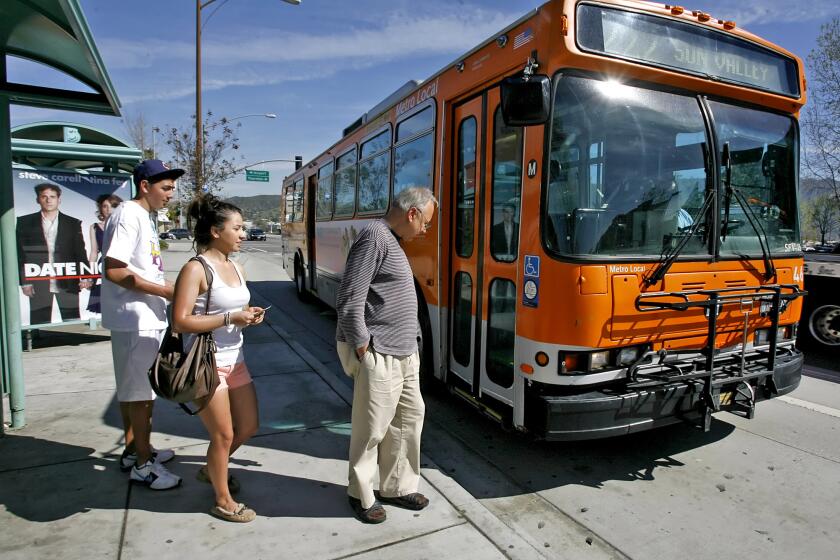High-Profile Business Plane Crashes Belie Safety
When the son of NBC sports chief Dick Ebersol perished with two others in a crash two weeks ago, it looked like yet another in a long string of tragic safety lapses in the nation’s fleet of small jet aircraft.
Two other high-profile crashes this fall involved small business planes. And in the last dozen years, accidents have taken the lives of business leaders, politicians and athletes: Sen. Paul Wellstone of Minnesota, In-N-Out Burger executives, golfer Payne Stewart and many others.
But a closer look at the record of private jet aviation reveals that as the industry has transformed itself into a powerhouse in the U.S. economy, it has achieved a safety record rivaling that of the airline industry.
Although statistics show small passenger jets are extremely safe, the accidents that do occur often point to sloppy practices, sometimes to poor training and a disregard for caution by companies that operate on a shoestring, experts say.
Corporations own and operate more than 10,000 private aircraft in the U.S. Those fall into two main categories: company-owned jets that transport their own executives and guests, and a large fleet of on-demand air taxis that have become routine transportation for the wealthy, powerful and famous. When crashes do happen, they often involve names the public recognizes.
Air safety experts, like Robert E. Breiling, say private corporate jets have a crash record about equal to U.S. airlines. In many cases, they have sophisticated safety equipment in the cockpit that surpasses anything used by scheduled carriers. Pilots receive simulator training just like airline crews.
Air taxi operators have a higher accident rate than airlines, but, within the subcategory that fly jet aircraft for regular clients, the record is also nearly as good as airlines.
In the last two months, however, the Ebersol accident and two others have raised concerns about possibly careless flight procedures in private aviation. A plane on its way to pick up former President George H.W. Bush, crashed into a light tower. In another, a plane carrying the Hendrick family of NASCAR racing fame slammed into a mountain, killing 10.
In the Ebersol crash, the plane was on the ground for more than half an hour during light snow and apparently was not de-iced before taking off. Small amounts of ice, snow and even water droplets can disrupt the flow over a wing and cause instability. The twin-engine Challenger jet crashed shortly after taking off, killing three people and leaving the copilot in critical condition with burns.
A spokesman for the National Transportation Safety Board said Friday that the cause of the accident was still under investigation, though the agency was aware of the weather conditions and was looking at whether icing played a role.
What’s more, Ebersol’s plane had been “double brokered,” meaning that the company arranging the flight did not have control of the aircraft, said Mark Fischer, executive vice president of Aviation Research Group/U.S., an aviation consultant that rates the safety of air charter companies. Fischer said the use of double brokers was a practice he advised clients to avoid.
Chuck Wyble, a spokesman for Air Castle, the company operating the Ebersol flight, acknowledged that it had been double brokered. Wyble described Air Castle as “a paper company” owned by Jet Alliance, a Millville, N.J., operator of seven jet aircraft.
Ebersol apparently contracted for the plane through charter operator Key Air, which did not have an available aircraft for the flight, Wyble said. Officials for Key Air did not return a call seeking comment.
“If the Ebersol family is calling you, you don’t want to say we can’t help you,” Wyble said. “You want to do everything you can for them.”
Ownership of the jet that carried Ebersol is further muddied, registration records at the Federal Aviation Administration show. The jet is technically owned by Hop-A-Jet, a Ft. Lauderdale, Fla.-based company. Mike Harvey, a Hop-A-Jet official, acknowledged that his company owned the aircraft but said it was leased to Jet Alliance.
The twisted relationships point out some of the potential pitfalls in the air taxi business. FAA spokesman Les Dorr said 2,432 companies operate air charter or air taxi services. The vast majority of those services use propeller planes, many ferrying sportsmen in remote areas in Alaska and elsewhere.
More than 800 companies operate turbine-powered aircraft, either jet or propjets, said Fischer, the ARG/US executive. The company, which rates every air taxi operator for safety, gives a platinum rating, its highest, to 36 companies that pass a rigorous on-site audit that goes well beyond routine FAA inspections. An additional 284 operators earn a gold rating, 470 a silver rating and 45 operators do not qualify for a rating.
The taxi services operate under FAA rules, known as Part 135, that also apply to small scheduled airlines, such as feeders and commuters. The agency has been increasing regulation of these operations so that they more closely match the rules that apply to major airlines, said Alfred Dickinson, director of the USC Aviation Safety and Security Program. Even so, the operators often don’t meet the standards of big airlines.
“The regulation of 135 carriers is not as strict,” said Dickinson, a former government crash investigator. “They are smaller outfits. They are operating on lesser budgets. They don’t have the resources of big airlines. A 135 operator may only own a couple planes, and if they do major maintenance on one and something happens to another one, they may not be flying at all.”
But accident data show clearly that corporate jets and even some air taxi operators are every bit as safe as airlines. It reflects the important economic role they have assumed over the last decade, particularly in recent years as concerns have grown about terrorist attacks on U.S. aviation.
Executives have sought to escape crowded airports and long security lines, while gaining greater protection from a potential terrorist hijacking.
“After 9/11, nobody wants to fly a scheduled carrier,” Breiling said. “It is just too crowded. And if you have five or six passengers paying first-class fares, you can charter a jet for the same price. The airlines are losing a lot of well-to-do passengers.”
In recent years, scheduled airlines have also dropped service to many small airports, forcing some companies to rely on private jets to reach remote manufacturing operations. Private aviation fuels an industry that accounts for more than $100 billion of economic activity, industry figures show.
Roughly 75% of small jets are made in the U.S.
Far from being death traps, the jets owned and operated by corporations for their employees have an average annual fatal accident rate over the last five years of .014 deaths per 100,000 flight hours -- roughly equal to the airline industry’s .012 rate, Breiling’s calculations show.
Some taxi services fly cargo, land at wilderness lakes, move body parts for transplant operations and operate air ambulance service, all of which can involve higher levels of risk. As a group, air taxi operators have a fatal accident rate five times higher than scheduled airlines.
But those taxi services that fly routine passengers on jet aircraft have an accident rate that is nearly as good as air carriers and private corporate jets, Breiling said.
Nonetheless, the public has the impression that small aircraft are less safe than the lumbering airliners that ferry the vast majority of Americans.
“People don’t understand,” said Edward Bolen, president of the National Business Aircraft Assn. “They may equate size with capability, but that’s a misimpression. These small jets have electronic capabilities that are every bit as sophisticated or more than airliners.”
In some cases, business jets have heads-up displays that are typically found only on military fighter jets. In other cases, they have enhanced vision systems that can see through clouds, he said.
The pilots of a Gulfstream jet en route to pick up Bush in Houston on Nov. 22 could certainly have used a system like that. They were flying in dense fog about a mile and a half from Hobby Airport when the plane clipped a 125-foot-tall light tower.
Because the airplane was not carrying paying passengers, it could operate under less-strict rules that apply to general aviation, known as Part 91 regulations. Under these rules, pilots can use visual approaches that would not be allowed under Part 135 rules that apply to air taxis. Breiling speculates that the pilots were trying to fly low enough to visually navigate through the fog and did not anticipate the unusually high tower.
Another high-profile crash, on Oct. 25 in Virginia, took the lives of four members of the Hendrick Motorsports family and six others. The Beech 200, which was flying from Concord, N.C., to Martinsville, Va., aborted a landing attempt in dense fog and then ran into the side of Bull Mountain. It gained widespread publicity because of the family’s prominence in NASCAR racing.
“Through November, there have been 11 accidents this year involving small business jets, five of which have been fatal,” Breiling said. He said that was “a little high.”







